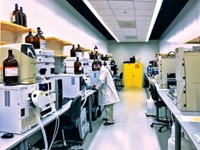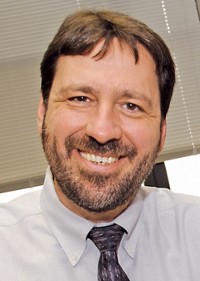Advertisement
Grab your lab coat. Let's get started
Welcome!
Welcome!
Create an account below to get 6 C&EN articles per month, receive newsletters and more - all free.
It seems this is your first time logging in online. Please enter the following information to continue.
As an ACS member you automatically get access to this site. All we need is few more details to create your reading experience.
Not you? Sign in with a different account.
Not you? Sign in with a different account.
ERROR 1
ERROR 1
ERROR 2
ERROR 2
ERROR 2
ERROR 2
ERROR 2
Password and Confirm password must match.
If you have an ACS member number, please enter it here so we can link this account to your membership. (optional)
ERROR 2
ACS values your privacy. By submitting your information, you are gaining access to C&EN and subscribing to our weekly newsletter. We use the information you provide to make your reading experience better, and we will never sell your data to third party members.
Business
Advancing R&D By Venture Philanthropy
Patient advocacy groups use venture capitalists’ tactics to accelerate search for cures
by Lisa M. Jarvis
November 5, 2012
| A version of this story appeared in
Volume 90, Issue 45

Some might call his work a passion project. P. Jeffrey Conn began a romance with metabotropic glutamate receptors (mGluRs) almost 25 years ago while a professor at Emory University. Conn was convinced that molecules that modulate one subtype of mGluRs, which help transmit chemical signals in brain cells, could provide Parkinson’s disease patients with the same improvements they saw after surgery that involves making lesions on the brain.
After a few years, Conn left academia for industry, where he anticipated a better opportunity to develop drugs that modulate the family of receptors. At Merck & Co., Conn pleaded the case for pursuing the target, but he wasn’t able to garner support. Even coming from him, the head of the firm’s neuroscience department, the plan was “too high risk, too out of the box,” he recalls.
In 2003, Conn moved on to Vanderbilt University, where he started the Vanderbilt Center for Neuroscience Drug Discovery, a venue intended to give scientists the freedom to explore unproven but potentially impactful drug targets. Just as important, the center would allow him to finally get the Parkinson’s program off the ground. There was only one problem: The National Institutes of Health could fund the basic science around mGluRs, but grants to cover follow-on drug discovery didn’t exist.
Enter the Michael J. Fox Foundation, a nonprofit started by the actor to find a cure for Parkinson’s disease. By the time Conn’s center was up and running, the Fox Foundation was jumping feetfirst into venture philanthropy, a strategy that has nonprofit organizations investing in projects and using tactics borrowed from the venture capital world. Under the foundation’s program, Conn’s lab received several million dollars to optimize molecules and develop drug candidates for Parkinson’s. In exchange, he agreed to pay the money back through a small royalty if one of the molecules made it to market.
Five years and several million dollars of Fox Foundation support later, Conn’s passion project has scored what many would consider the ultimate validation: a licensing deal with a big pharmaceutical company. In September, Bristol-Myers Squibb paid an undisclosed sum to team up with the Vanderbilt center to develop positive allosteric modulators of mGluR4 for the treatment of Parkinson’s disease. The compounds Conn and his team discovered have yet to be validated in humans, but with a big pharma backer, their move into the clinic should be swift.
The deal with BMS is more than a confirmation of Conn’s long-standing belief that mGluRs are worthwhile drug targets. It is another data point suggesting that venture philanthropy is an effective way to remove some of the risk around a new drug target or class of compounds. Although still a small part of drug R&D financing, venture philanthropy has become an important way to bridge the funding gap between preclinical studies and early tests in patients.
Nonprofits like the Fox Foundation, the Leukemia & Lymphoma Society (LLS), and the Multiple Myeloma Research Foundation (MMRF) are just a few years into efforts to fund drug development, but they are already seeing gains from their investments. Pacts like the one between Vanderbilt and BMS have been sealed, drug candidates are moving into human testing at an accelerated pace, and nonprofit money is removing enough uncertainty around some drug targets to entice other companies to invest in similar R&D.
Small companies or academic scientists interested in turning an idea into a company have long had a tough time finding resources for their projects, and the situation only became worse after the financial crisis of 2008. Although the overall rate of venture capital investment in the biotech industry has recovered somewhat and now holds steady at $4.0 billion to $4.5 billion a year, most firms are putting money into their existing investments rather than new companies, says Glen T. Giovannetti, who heads the life sciences group at the consulting firm Ernst & Young.
Meanwhile, big pharmaceutical companies have cut back on in-house drug discovery, making them more reliant than ever on the outside world to fill their new-product pipelines. Patient advocacy groups have found themselves filling this gap. Their role has become increasingly important, according to G. Steven Burrill, chief executive officer of the life sciences investment firm Burrill & Co. “There’s been a massive shift in the last five years,” he says.
Epizyme, a Cambridge, Mass.-based biotech firm focused on drugs that modulate epigenetic targets, would have developed its pipeline much more slowly without the support of patient advocacy groups, says Jason P. Rhodes, its chief business officer. Before any big pharma partners surfaced, Epizyme secured deals with both LLS and MMRF.
The funding came at a critical juncture in the young biotech’s existence, Rhodes says. For example, the $7.5 million it received from LLS, committed in staged payments, allowed Epizyme to move its first drug candidate, a small molecule that inhibits the epigenetic target DOT1L, into Phase I studies. It reached the milestone in September.
Epizyme has gone on to seal broad partnerships with GlaxoSmithKline and Celgene that encompass targets first explored in the pacts with LLS and MMRF. “These foundations bring much more than simply funding,” Rhodes says. “They have real insight and a very good view of the landscape—what research is going on.”
Patient advocates have emerged as a small but savvy group of investors. Not long ago, venture capitalists tended to view investments by nonprofits as a nice way for a biotech firm to add nondilutive capital to its balance sheet, but they did not see venture philanthropy as a critical part of the landscape, patient groups say. Today, as capital tightens and success stories accumulate, those same venture capitalists “are sitting at the table with us,” says Robert J. Beall, president of the Cystic Fibrosis Foundation (CFF).

That shift in perception is in no small part a result of the approval in January of Vertex Pharmaceuticals’ Kalydeco, a drug that corrects the genetic mutation driving cystic fibrosis in certain people with the disease. CFF had contributed some $75 million toward Kalydeco’s development and now receives a small royalty on the drug’s sales, which should reach $200 million this year, according to Needham & Co. stock analyst Alan Carr. Overall, CFF has spent roughly $375 million to help pharmaceutical industry partners develop treatments for cystic fibrosis.
Beyond the success with Kalydeco, evidence is mounting that venture philanthropy is a good way to “de-risk” therapy ideas enough for a commercial entity to invest in them, says Todd Sherer, CEO of the Fox Foundation. Patient groups point to deals in which a large company assumes the cost of developing a venture philanthropy project. For example, funding from MMRF helped move an Intellikine cancer drug candidate, INK128, into Phase I studies. Data generated during the studies enticed Takeda Pharmaceutical to pay up to $310 million last year to acquire Intellikine.
Overall, five projects funded through the Therapy Acceleration Program, LLS’s avenue for funding biotechs, received outside investments in just the past year. “We believe it’s been remarkably successful,” says Louis J. DeGennaro, LLS’s chief mission officer.
LLS entered venture philanthropy to accelerate the rate at which blood cancer therapies are developed. The idea was to move projects forward so that companies would be in a position to raise more capital either through a venture investment round or through a partnership with a large biotech or pharma firm. “All of those things have come to fruition,” DeGennaro adds.
Beyond deal-making, partnerships between nonprofits and drug discovery organizations can entice new players into a field. In the case of Conn’s mGluR program, the basic science and preclinical data that he generated and published with the support of the Fox Foundation helped remove some of the mystery around the receptors. Since then, Merck KGaA has teamed with Domain Therapeutics to discover modulators of mGluR4, and Merck & Co. signed on to work with Addex Pharmaceuticals on mGluR5 modulators for Parkinson’s, although the deal fell apart last year.
Seeing the potential of drugs for rare or orphan diseases, big pharma companies are now trying to find a way to partner directly with venture philanthropists. When Beall gave his first talk about venture philanthropy some 12 years ago, he had an audience of about five people, he recalls, mainly patient advocates interested in replicating CFF’s model.
Today, the nonprofit types sit shoulder-to-shoulder with pharmaceutical executives seeking to carve a position in the rare-disease market. An example of their interest is a pact CFF signed with Pfizer in late 2011 for the discovery of compounds to treat the most common mutation in people with cystic fibrosis.
The investments made by nonprofit groups are growing as the model shows signs of success. LLS, for example, has expanded the budget for its Therapy Acceleration Program from $4 million in 2007, the year it launched, to $20 million in the current fiscal year, DeGennaro notes.
The Fox Foundation has also increased the amount of money it is devoting to drug development. Since the inception of its venture philanthropy program, the nonprofit has sunk $81 million into 170 industry partnerships, including $11.8 million last year.
As the Fox Foundation has increased its investment in drug discovery, it is deploying the funds in a smarter way, according to Sherer. The nonprofit has gotten better at quickly identifying the key experiment that will get a program to a decision point—that “yes” or “no” stage of drug development—as well as conducting that research more efficiently, he says.
“In the early days of the foundation, we funded projects on important therapeutic approaches,” Sherer recalls. “In retrospect, for the same amount of money or less money, we could have gotten to the critical answer, to determine whether we should move it forward, more quickly.”
Beall’s advice for flattening the learning curve is to hold partners accountable. “You’ve got to run it like a business,” he says. “We have a checklist of 20 to 30 items we like to see included in our contracts.” One requirement is putting CFF scientific advisers who understand the disease on the project. Another is clearly delineated financial terms—and not just about how to split profits if a drug candidate succeeds. If a company decides to drop a project, Beall notes, it must pay CFF back.
And just like venture capitalists, venture philanthropists must know when to cut their losses. Although nonprofits typically make investment decisions with the help of advisers—a team that includes medical, scientific, business development, and intellectual property experts—a drug candidate can fail because of toxicity, solubility, or any of a number of issues, LLS’s DeGennaro says. “When that has happened, we have not been afraid to pull the plug on the program.”
As evidence mounts that venture philanthropy can be an effective way to spur drug development for underserved diseases, more nonprofits are considering it. Beall, who speaks to many organizations about how CFF began investing, points to Autism Now and JDRF (formerly known as the Juvenile Diabetes Research Foundation) as the most recent nonprofits to make a foray into funding drug discovery.
Meanwhile, organizations with a few successful deals under their belts are broadening their efforts. The Fox Foundation, for example, has a multifaceted approach to removing roadblocks along the drug development pathway. The nonprofit has coordinated precompetitive collaborations around biomarkers and improving animal models for Parkinson’s disease. On the basis of feedback that recruiting patients for clinical trials is a bottleneck, the foundation recently unveiled a database of studies and patients interested in signing up for trials.
LLS is complementing its Therapy Acceleration Program, which funds drugs that are ready for, or are already in, human studies, with its recently launched Targets, Leads & Candidates Program, which backs earlier-stage projects. Focused on pulling ideas out of academia, the new effort seeks to elucidate basic science or develop molecules against intriguing drug targets.
Celgene has signed on as the new program’s first pharmaceutical partner. Under the pact, the partners will jointly decide on areas of study, whether for a specific drug target or a therapeutic indication. They will then select the best academic proposals, to be funded by Celgene. The biotech company will later have first dibs at licensing lead molecules that come out of those efforts.
Advertisement
Because LLS has been funding research for nearly 50 years, “we’re a well-known commodity in the academic arena,” DeGennaro says. “People know and trust our system, and that’s part of our ability to bridge between academia and the private sector.”
For its part, Celgene signed on after realizing that many of the deals it had made in recent years were for drug candidates or whole companies that had been supported by LLS. “It’s a chance to work very closely with LLS, which has a great track record in this type of endeavor,” says George Golumbeski, Celgene’s head of business development. “It’s also a chance to prime the pump in areas that we’re interested in.”





Join the conversation
Contact the reporter
Submit a Letter to the Editor for publication
Engage with us on Twitter